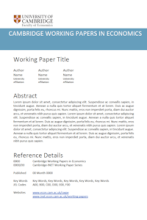The goal of our project is to develop and apply econometric techniques to detect anthropogenic patterns in climate change and forecast its consequences. We interpret the subject of climate widely to include environmental issues in general and entitle our project Forecasting and Policy in Environmental Econometrics.
We have investigated climate sensitivity, which measures how much global temperature responds to an increase in carbon emissions. Our results indicate that the confidence intervals vary greatly if one considers time horizons beyond the current methodologies’ stipulated ‘long- run’ equilibrium. The leading application of our statistical results concerned the relationship between radiative forcing, Earth’s ability to trap heat, and global average temperature deviation as shown in Figure 1. A major advance of this project was to estimate climate sensitivity at shorter timescales. This result is on display in Figure 2. Strikingly, shorter-lived gases correspond to a higher temperature parameter. More information on our achievements to date and on-going collaborations is available in Section 1.1. There is a notable commitment in the scientific community to study climate sensitivity. Indeed, Klaus Hasselmann, the author of the underlying theory of our sensitivity study, has just received the Nobel Prize in Physics along with two other climate researchers
We now seek to establish a new project that transfers econometric knowledge to the domain of climate statistics and integrates climate science into economic knowledge. We will structure our project around four research questions. The first (Section 2.1.1) concerns the development of statistical techniques to analyse environmental time series and the building of a forecasting model for policy-relevant environmental outcomes. The second (Section 2.1.2) seeks to estimate climate sensitivity in a way that tightens error bars. The third (Section 2.1.3) will establish a method to conduct inference on the expected timescale at which temperature series revert to a long-run mean. The fourth question (Section 2.1.4) addresses the equilibrium effects of a changing climate in a production economy.
Firstly, we will use a model developed for studying changing regimes in financial time series to classify ice ages. We use data from the paleorecord, covering approximately 800, 000 years. The goal of this strand of our work is to classify ‘ice states’ into warm periods and ice ages, and to be able to forecast their incidence. Earth’s orbital geometry serves as an exogenous forcing sequence that non-linearly shifts ice age probability over time. This relationship is equivalent to modeling Earth’s cryosphere as a relaxation oscillator. The application of this study is to find further statistical evidence of the Milankovitch theory of ice ages that partitions ice growth and decay. We interpret forecast failure as evidence for anthropogenic intervention.
Secondly, we will enrich the Hasselmann model with econometric techniques developed for the modeling of investment and interest rates, which are often sampled at different frequencies, just like climatological variables. Indeed, a major roadblock in current climate econometric research is the fact that data are very heterogeneous. We shall meet these challenges by using a type of statistical model specifically designed for mixed-frequency and mixed-type data.
Our third project aims to construct confidence intervals for the relevant timescales at which long-run temperature and forcing equilibria are met. Statistically, such inference procedure has the goal to eliminate some of the estimated coefficients in Figure 2 to make the inferences more precise. It would also allow a reduction of the many intervals in Figure 2 to a single interval for the sensitivity parameter.
Finally, we seek to develop a general equilibrium model to measure the economic impact of changing temperatures, floodings, and drought incidence. Detailed projections were just released with the Sixth Synthesis report of the Intergovernmental Panel on Climate Change. Hsiang and Kopp (2018) remarked in the Journal of Economic Literature that too deep a division exists between climate researchers and economists. Simulations of the climate and human adaptation often utilise economic forecasts made with close to no contribution from economists. We seek to engage in this dialogue between economists and climate researchers by modelling the relation- ship between firms’ behaviours and expectations of a changing climate and the implied climate ramifications, which feed back to the firms themselves. IPCC projections form a baseline scenario against which we compare our results. This study is joint with Cambridge post-doctoral researcher Hanbaek Lee who will join the University of Tokyo as an Assistant Professor next academic year.
Our project will make important contributions to scientific knowledge and further our un- derstanding and prediction of climatic and environmental data. Econometricians’ techniques from the last fifty years are very different from climate scientists’ approach, which provides opportunities to address long-standing problems in climate research with fresh methods. Both economists and climate scientists now confront a mix of physical and economic data and, most importantly, the same challenge. Anthropogenic climate change and adverse ramifications perhaps present the greatest market failure of all time. Its statistical study, an estimate of its eco- nomic consequences, and modelling the interaction between economies and the climate therefore all lie within the aims and objectives of the Keynes fund. Indeed, both sources and consequences of climate change originate from failure of market efficiency: the actions or inaction of the generations currently alive generate agency costs that future generations have to bear as climate change causes livelihoods to disintegrate.
Cointegration without Unit Roots
Cointegration without Unit Roots, James A. Duffy and Jerome R. Simons, Cambridge Working Papers in Economics (2023)
It has been known since Elliott (1998) that standard methods of inference on cointegrating relationships break down entirely when autoregressive roots are near but not exactly equal to unity. We consider this problem within the framework of a structural VAR, arguing this it is as much a problem of identification failure as it is of inference. We develop a characterisation of cointegration based on the impulse response function, which allows long-run equilibrium relationships to remain identified even in the absence of exact unit roots. Our approach also provides a framework in which the structural shocks driving the common persistent components continue to be identified via long-run restrictions, just as in an SVAR with exact unit roots. We show that inference on the cointegrating relationships is affected by nuisance parameters, in a manner familiar from predictive regression; indeed the two problems are asymptotically equivalent. By adapting the approach of Elliott, Müller and Watson (2015) to our setting, we develop tests that robustly control size while sacrificing little power (relative to tests that are efficient in the presence of exact unit roots).



